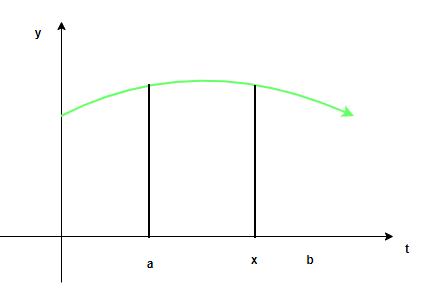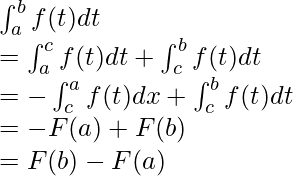用微积分基本定理求导
积分是微分的逆过程。它们也被称为反导数,用于找出我们没有可用公式的任意形状的面积和体积。不定积分只是计算函数的反导数,而定积分有极限,通常表示曲线下的面积。微积分的基本定理将积分规则与导数和链式规则联系起来。它用于解决集成中的难题。让我们看看这个定理。
应用微积分基本定理
将函数f(x) 视为在给定区间 [a, b] 内连续且可微的函数。这些限制之间的定积分表示为![]() .这被定义为由函数f(x) 和 x 轴在限制 x = a 和 x = b 之间包围的区域。这个定积分可以通过改变极限的上限转换成一个函数。这个函数可以重写为,
.这被定义为由函数f(x) 和 x 轴在限制 x = a 和 x = b 之间包围的区域。这个定积分可以通过改变极限的上限转换成一个函数。这个函数可以重写为,
让![]() .现在从几何上讲,这个函数给出了同一曲线下的面积,但从 x = a 到 x,其中 x 位于极限边界之间。下图显示了这个函数:
.现在从几何上讲,这个函数给出了同一曲线下的面积,但从 x = a 到 x,其中 x 位于极限边界之间。下图显示了这个函数:

现在在 x = a, 
基本定理使我们能够计算给定函数的导数。
Fundamental Theorem of Calculus – Part I
For a function f which is continuous and differentiable on the interval [a, b], suppose ![]() . Then, F is a differentiable function on (a, b), and
. Then, F is a differentiable function on (a, b), and
F'(x) = f(x)
这个定理看似微不足道,却有着非常深远的影响。有一个函数f(x) = x 2 + sin(x),
给定,F(x) = ![]()
根据上述基本定理,

这个定理可以用来推导出一个流行的结果,
假设有一个定积分![]() .另外,假设 F(x) =
.另外,假设 F(x) = ![]() .
.

这是微积分基本定理的第二部分。
Fundamental Theorem of Calculus – Part II
For a function f which is continuous and differentiable on the interval [a, b], let F be any anti-derivative of the given function. Then,
![]()
使用链式法则应用基本定理
定积分的难题可以通过链式法则和微积分基本定理相结合来解决。例如,
![]()
为了解决这些问题,我们需要一个更广义的基本定理。
For a function f which is continuous and two other functions g and h which are differentiable,
![Rendered by QuickLaTeX.com \frac{d}{dx}\int^{h(x)}_{g(x)}f(s)ds = \frac{d}{dx}[F(h(x)) - F(g(x))] \\ = F'(h(x))h'(x) - F'(g(x))g'(x) \\ = f((h(x))h'(x) - f(g(x))g'(x)](https://mangodoc.oss-cn-beijing.aliyuncs.com/geek8geeks/Finding_Derivative_with_Fundamental_Theorem_of_Calculus_12.jpg)
让我们看看与这些概念相关的一些问题。
示例问题
问题 1:给定以下函数F(x),计算其导数。
F(x) = ![]()
解决方案:
Given: F(x) = ![]()
![]()
This can be solved using the fundamental theorem of calculus part – I

问题 2:给定以下函数F(x),计算其导数。
F(x) = ![]()
解决方案:
Given: F(x) = ![]()
![]()
This can be solved using the fundamental theorem of calculus part – I

问题 3:给定以下函数F(x),计算其导数。
F(x) = ![]()
解决方案:
Given: F(x) = ![]()
![]()
This can be solved using the generalized form of the fundamental theorem of calculus part – I. It states that,
![Rendered by QuickLaTeX.com \frac{d}{dx}\int^{h(x)}_{g(x)}f(s)ds = \frac{d}{dx}[F(h(x)) - F(g(x))] \\ = F'(h(x))h'(x) - F'(g(x))g'(x) \\ = f((h(x))h'(x) - f(g(x))g'(x)](https://mangodoc.oss-cn-beijing.aliyuncs.com/geek8geeks/Finding_Derivative_with_Fundamental_Theorem_of_Calculus_24.jpg)
Here, f(t) = et, h(x) = x2 and g(x) = 0

问题 4:给定以下函数F(x),计算其导数。
F(x) = ![]()
解决方案:
Given: F(x) = ![]()
![]()
This can be solved using the generalized form of the fundamental theorem of calculus part – I. It states that,
![Rendered by QuickLaTeX.com \frac{d}{dx}\int^{h(x)}_{g(x)}f(s)ds = \frac{d}{dx}[F(h(x)) - F(g(x))] \\ = F'(h(x))h'(x) - F'(g(x))g'(x) \\ = f((h(x))h'(x) - f(g(x))g'(x)](https://mangodoc.oss-cn-beijing.aliyuncs.com/geek8geeks/Finding_Derivative_with_Fundamental_Theorem_of_Calculus_29.jpg)
Here, f(t) = cos(t), h(x) = x3 and g(x) = 0

问题 5:给定以下函数F(x),计算其导数。
F(x) = ![]()
解决方案:
Given: F(x) = ![]()
![]()
This can be solved using the generalized form of the fundamental theorem of calculus part – I. It states that,
![Rendered by QuickLaTeX.com \frac{d}{dx}\int^{h(x)}_{g(x)}f(s)ds = \frac{d}{dx}[F(h(x)) - F(g(x))] \\ = F'(h(x))h'(x) - F'(g(x))g'(x) \\ = f((h(x))h'(x) - f(g(x))g'(x)](https://mangodoc.oss-cn-beijing.aliyuncs.com/geek8geeks/Finding_Derivative_with_Fundamental_Theorem_of_Calculus_34.jpg)
Here, f(t) = t + 2, g(x) = 0 and h(x) = sin(x)

问题 6:给定以下函数F(x),计算其导数。
F(x) = ![]()
解决方案:
Given: F(x) = ![]()
![]()
This can be solved using the generalized form of the fundamental theorem of calculus part – I. It states that,
![Rendered by QuickLaTeX.com \frac{d}{dx}\int^{h(x)}_{g(x)}f(s)ds = \frac{d}{dx}[F(h(x)) - F(g(x))] \\ = F'(h(x))h'(x) - F'(g(x))g'(x) \\ = f((h(x))h'(x) - f(g(x))g'(x)](https://mangodoc.oss-cn-beijing.aliyuncs.com/geek8geeks/Finding_Derivative_with_Fundamental_Theorem_of_Calculus_39.jpg)
Here, f(t) = t, g(x) = 0 and h(x) = cos(x)
